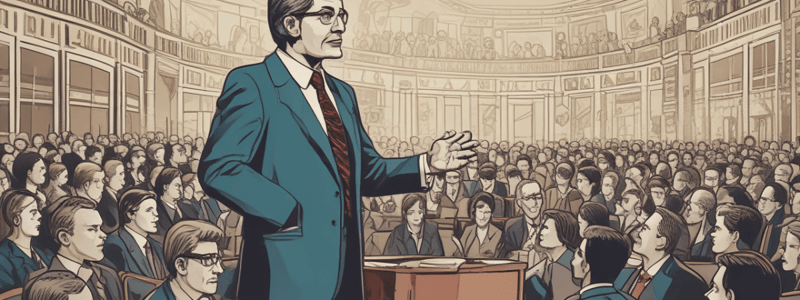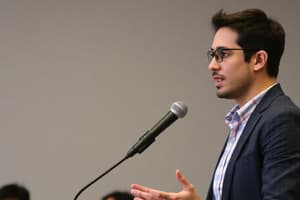Podcast
Questions and Answers
What is the author's purpose when they write to inform?
What is the author's purpose when they write to inform?
- To convince the reader to take a certain action
- To tell a fictional story
- To provide facts or true information about a subject (correct)
- To persuade the reader to adopt a particular viewpoint
What is the term for the art of persuasion?
What is the term for the art of persuasion?
- Author's Purpose
- Rhetorical Situation
- Main Idea
- Rhetoric (correct)
When an author uses research and statistics to support an argument, they are using which rhetorical appeal?
When an author uses research and statistics to support an argument, they are using which rhetorical appeal?
- Ethos
- Logos (correct)
- Author's Purpose
- Pathos
What is the main idea statement in the author's purpose equation?
What is the main idea statement in the author's purpose equation?
When an author writes fiction, what is their purpose?
When an author writes fiction, what is their purpose?
What is the term for the combination of the author's purpose and the main idea statement?
What is the term for the combination of the author's purpose and the main idea statement?
What is the primary purpose of understanding the audience's expectations, prior knowledge, and experience?
What is the primary purpose of understanding the audience's expectations, prior knowledge, and experience?
What are the three main components of the rhetorical situation?
What are the three main components of the rhetorical situation?
What is the primary goal of a presentation that aims to persuade?
What is the primary goal of a presentation that aims to persuade?
What is the role of the space and time in the context of a presentation?
What is the role of the space and time in the context of a presentation?
What is the purpose of identifying the audience's characteristics, such as social class, gender, and cultural background?
What is the purpose of identifying the audience's characteristics, such as social class, gender, and cultural background?
What is the acronym PIE an abbreviation for in the context of presentation goals?
What is the acronym PIE an abbreviation for in the context of presentation goals?
What is the primary purpose of using structural parts of a presentation?
What is the primary purpose of using structural parts of a presentation?
What is the primary benefit of using different organizing principles for a presentation?
What is the primary benefit of using different organizing principles for a presentation?
What is the primary goal of considering the audience in a rhetorical situation?
What is the primary goal of considering the audience in a rhetorical situation?
Which of the following is an example of a Logos appeal?
Which of the following is an example of a Logos appeal?
What is the primary purpose of a presentation?
What is the primary purpose of a presentation?
What is the key component of a rhetorical situation that connects to the broader world?
What is the key component of a rhetorical situation that connects to the broader world?
Which of the following is an example of an Ethos appeal?
Which of the following is an example of an Ethos appeal?
What is the central element of a speech's structure?
What is the central element of a speech's structure?
Which of the following is an example of a Pathos appeal?
Which of the following is an example of a Pathos appeal?
What is the primary consideration for choosing the format of an informal report?
What is the primary consideration for choosing the format of an informal report?
What is a fact based on according to a reliable authority?
What is a fact based on according to a reliable authority?
Which of the following is NOT a reliable authority for proving facts?
Which of the following is NOT a reliable authority for proving facts?
What is the purpose of outlining your presentation according to Owl Purdue?
What is the purpose of outlining your presentation according to Owl Purdue?
What type of authority is a mathematics based on?
What type of authority is a mathematics based on?
What type of authority is a history book based on?
What type of authority is a history book based on?
What type of authority is a scientific law based on?
What type of authority is a scientific law based on?
What is involved in the audience's expectations of a speaker?
What is involved in the audience's expectations of a speaker?
What is the purpose of referencing in a speech?
What is the purpose of referencing in a speech?
What are the three contributing elements to a specific purpose statement?
What are the three contributing elements to a specific purpose statement?
What is the difference between a fact and an opinion?
What is the difference between a fact and an opinion?
What is the purpose of the formula for creating a specific purpose statement?
What is the purpose of the formula for creating a specific purpose statement?
What is an example of a specific purpose statement?
What is an example of a specific purpose statement?
What is the role of facts in supporting an opinion?
What is the role of facts in supporting an opinion?
What is the relationship between a widely accepted opinion and a fact?
What is the relationship between a widely accepted opinion and a fact?
Study Notes
Planning and Organizing a Presentation
- A presentation is affected by the space, time, and events surrounding it, which influence preparation decisions.
- The audience brings expectations, prior knowledge, and experience, and has diverse characteristics like social class, gender, age, race, and ethnicity.
- The purpose of a presentation is central to its formation and can be to inform, demonstrate, persuade, motivate, or entertain.
Rhetorical Situation
- Rhetoric is the art of persuasion, originally explored by Aristotle in his book "Rhetoric".
- A rhetorical situation consists of three elements: context, audience, and purpose.
- Context includes the presentation space, time of day, and current events.
- Audience is a key component of communication, with diverse expectations, knowledge, and experiences.
- Purpose is central to the speech's structure and can be stated in one concise sentence.
Aristotle's Form of Rhetorical Proof
- Ethos is an appeal to credibility, using experience and specialized knowledge to highlight credibility.
- Pathos is an appeal to emotions, using vivid language and storytelling to persuade.
- Logos is an appeal to logic, using research and statistics to support an argument.
Strategies for Success
- Expectation involves understanding the audience's inherent expectations of themselves and the speaker.
- Reference involves attention to the source and presentation of information.
Purpose and Central Idea Statements
- A specific purpose statement formula is: "To [specific communication word] my [target audience] [the content]".
- A central idea statement should be clear, concise, and focused.
Creating an Outline
- An outline is a roadmap for a presentation, helping to organize ideas and structure the content.
- The OWL Purdue website provides resources on how to outline a presentation.
Facts and Opinions
- Facts are statements that can be proven, while opinions are based on thoughts, feelings, and understanding.
- Facts can be supported by reliable authorities such as history books, statistics, scientific laws, and governmental laws.
- Opinions, even if widely accepted, are not facts.
Studying That Suits You
Use AI to generate personalized quizzes and flashcards to suit your learning preferences.
Related Documents
Description
This quiz reviews the key components of the rhetorical situation and effective presentation skills, including the use of cognate strategies, structural parts, and organizing principles.




